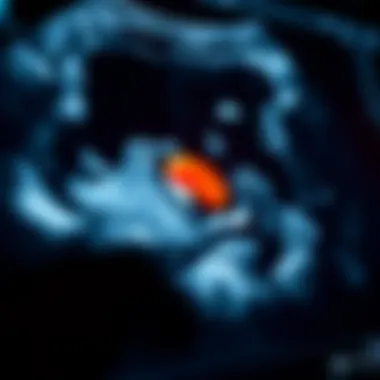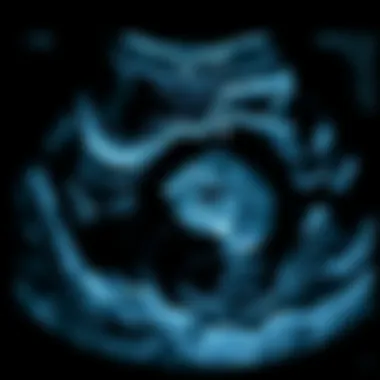Ultrasound Imaging for Understanding Uterine Fibroids


Intro
Fibroids, often characterized as benign tumors in the uterus, can pose significant challenges in both diagnosis and management. Understanding their presence and implications is crucial for providing effective patient care. Ultrasound imaging emerges as a cornerstone in this journey, offering a non-invasive method to detect and assess these growths. Each fibroid, depending on size and location, can impact a woman's health differently, making precise imaging and interpretation vital.
The significance of this topic extends beyond just the clinical setting. With growing awareness and discussion surrounding women’s health, a thorough understanding of fibroids and their imaging characteristics can empower patients, informing them about treatment options and self-care methods.
By delving into the intricacies of ultrasound findings, healthcare professionals and researchers can enhance their expertise, ultimately leading to better outcomes for those affected by fibroids. In the sections that follow, we will parse out the distinct kinds of fibroids identified through ultrasound, interpret the imaging results, and discuss their broader implications in patient management.
Foreword to Fibroids and Ultrasound
Fibroids, formally termed uterine leiomyomas, constitute a prevalent condition affecting numerous women across varying age groups. These benign tumors arise from the smooth muscle of the uterus and often lead to a myriad of symptoms, which can significantly impact quality of life. The importance of understanding fibroids lies not only in their prevalence but also in their potential for complications including heavy bleeding, pelvic pain, and reproductive challenges.
Ultrasound imaging emerges as a fundamental tool in diagnosing and characterizing fibroids. This non-invasive procedure allows clinicians to visualize the uterus in real time, providing invaluable insights into the number, size, and location of fibroids. Such information is crucial for developing appropriate treatment plans tailored to the individual needs of patients.
Ultrasound in the gynecological realm doesn’t merely aid in identifying fibroids, it brings forth broader implications for patient management. The ability to categorize fibroids through imaging informs clinicians about treatment options ranging from monitoring to surgical interventions. Therefore, understanding the intricacies of both fibroids and the role of ultrasound is pivotal for healthcare professionals, patients, and researchers alike.
Defining Fibroids
Fibroids vary widely in terms of their size, location, and symptoms. To broadly define them, fibroids can be categorized as follows:
- Subserosal Fibroids: These form on the outer layer of the uterus and may extend into the pelvic cavity, sometimes causing pressure on adjacent organs.
- Intramural Fibroids: Located within the muscular wall of the uterus, these are the most common type and can distort the uterine cavity, leading to menstrual irregularities.
- Submucosal Fibroids: Situated just beneath the inner lining of the uterus, these types can significantly impact fertility and are often associated with heavy menstrual bleeding.
Each type carries its own set of potential complications, necessitating a tailored approach to treatment options. Women often endure various experiences with fibroids, and understanding these differences is crucial in providing empathetic care.
Role of Ultrasound in Gynecological Evaluation
Ultrasound plays a pivotal role in gynecological evaluations, especially in diagnosing fibroids. The advantages of using ultrasound in this context cannot be overstated. For one, it serves as a first-line imaging technique due to its accessibility and ease of use. Additionally, ultrasound is safe, with no ionizing radiation involved, making it suitable for pregnant patients and repeated examinations.
Key benefits of ultrasound in evaluating fibroids include:
- Real-Time Imaging: The advantage of observing live images allows for immediate decision-making regarding further interventions or monitoring.
- Differentiation: Ultrasound helps distinguish fibroids from other uterine lesions or pathologies, essential for accurate diagnosis.
- Guidance for Treatment: The clarity provided in ultrasound images helps guide potential treatment options, whether that be conservative management or surgical intervention.
By leveraging these capabilities, healthcare providers can effectively manage conditions related to fibroids, leading to improved health outcomes for women.
Overall, a clear understanding of fibroids and the instrumental role of ultrasound in their evaluation allows clinicians to navigate the complexities of this common yet impactful condition, ultimately fostering better patient care.
Types of Fibroids
Understanding the various types of fibroids is crucial for a well-rounded insight into how these growths might impact women’s health. Fibroids can have different locations, sizes, and characteristics, all of which affect diagnosis, management, and treatment decisions. In this section, we will delve into three primary types of fibroids: subserosal, intramural, and submucosal fibroids. Each type presents unique challenges and implications when it comes to ultrasound imaging, and knowing the distinctions can aid healthcare providers in tailoring the right approach for individual patients.
Subserosal Fibroids
Subserosal fibroids develop on the outer wall of the uterus and often can extend outward, potentially affecting surrounding organs. These fibroids are generally easier to visualize via imaging techniques, especially ultrasound. Their location means they might not always cause significant symptoms unless they grow large enough to press against adjacent structures. Patients could experience pressure or discomfort in the lower abdomen or back pain, which can sometimes be mistaken for other conditions.
"While many women with subserosal fibroids are asymptomatic, monitoring their growth through regular ultrasound is vital to avoid complications."
Generally speaking, the size and growth rate of subserosal fibroids can vary widely between individuals. For some, a routine check-up may uncover subserosal fibroids that require no immediate action. For others, particularly if the fibroid enlarges or begins to lead to complications, treatment options such as watchful waiting, medication, or even surgical intervention may need consideration.
Intramural Fibroids
Intramural fibroids reside within the uterine muscle itself. These fibroids can be the most common type, often presenting as deformities in the uterine structure. They can cause heavy menstrual bleeding, pain during menstruation, and sometimes even infertility.
From an ultrasound perspective, intramural fibroids typically appear as well-defined masses within the muscle layer of the uterus. The nature of these fibroids may complicate management decisions, particularly when they significantly alter uterine shape or interfere with normal menstrual cycles. The fact that they are embedded in the muscle means they might not be as easily accessible as others, potentially influencing treatment choices.
Submucosal Fibroids


Submucosal fibroids are located just beneath the lining of the uterine cavity and can protrude into the uterus. They are often associated with more severe symptoms compared to other types, including heavy bleeding and longer menstrual periods. Their location can also lead to complications like endometrial dysfunction.
On ultrasound, submucosal fibroids may appear as irregular, nodular structures near the endometrial layer. Their distinctive positioning means they may be linked more often with reproductive issues, including infertility or pregnancy complications. If diagnosed, appropriate interventions based on the ultrasound findings might include surgical procedures like hysteroscopic myomectomy, where fibroids are removed through the cervix, sparing the outer uterine wall.
Each type of fibroid carries its significance and warrants a tailored approach in management, especially regarding imaging for accurate diagnosis. Overall, recognizing the differences among subserosal, intramural, and submucosal fibroids allows healthcare providers to frame a comprehensive and individualized care plan for patients.
Ultrasound Technologies for Fibroid Detection
The landscape of fibroid detection has evolved significantly, and ultrasound technologies sit at the forefront of this development. Their role is not merely to identify fibroids but to help clinicians visualize their characteristics, which is crucial for planning treatment. The benefits of employing ultrasound technologies are manifold. They are non-invasive, widely accessible, and provide real-time imaging capabilities. This is especially impactful given that many patients may have concerns about more invasive diagnostic options.
In essence, ultrasound imaging serves as a first-line approach in diagnosing uterine fibroids. This is essential because the detailed insight it provides helps clinicians discern which specific type of fibroid is present, thus influencing management strategies.
Transabdominal Ultrasound
Transabdominal ultrasound is typically one of the initial imaging techniques employed in the assessment of fibroids. This method uses a transducer placed on the abdomen, which emits sound waves to create images of the pelvic organs.
- Advantages:
- Wide Field of View: It allows for a broader perspective, enabling the visualization of not just the uterus, but also the ovaries and surrounding structures.
- Non-invasive: The absence of need for internal examination can be more comfortable for many patients.
However, this technique does have its limitations. The quality of images can vary based on factors such as body habitus and may sometimes be inadequate for detailed evaluation of smaller fibroids or those located in certain positions.
Transvaginal Ultrasound
In contrast, transvaginal ultrasound involves inserting a probe into the vaginal canal, providing much closer proximity to the uterus. This results in enhanced image resolution, making it particularly effective in identifying and characterizing fibroids.
- Benefits:
- Superior Detail: The close range significantly increases the clarity of images, allowing for better assessment of fibroid size and vascularity.
- Patient Comfort: For many women, it may be a more straightforward procedure, especially for those already familiar with gynecological examinations.
While this method might be perceived as more invasive, it generally comes with minimal discomfort and offers critical insights that help in tailoring subsequent management plans.
Three-Dimensional Ultrasound
Three-dimensional ultrasound takes imaging a step further by providing a volumetric view of the uterus and the fibroids within it. This technique is noteworthy for its ability to offer a realistic and reproducible anatomical representation, which can be quite beneficial in assessing complex cases.
- Noteworthy Advantages:
- Comprehensive Visualization: It can distinctly display the relationship between fibroids and surrounding anatomical structures.
- Detailed Measurements: 3D ultrasound allows for accurate volumetric assessments of fibroid dimensions, contributing decisively to treatment planning.
This advanced imaging modality is increasingly being integrated into clinical practice, proving particularly useful in preoperative evaluations and patient counseling.
"Ultrasound is not just a tool; it’s an essential partner in the journey of understanding fibroids, playing a central role in both diagnosis and ongoing management."
Interpreting Ultrasound Findings
Interpreting ultrasound findings is a crux in comprehending fibroid diagnosis and management. The precision of ultrasound imaging allows clinicians and radiologists to decipher distinct elements presented in the images, ultimately influencing patient care. This section delves into the key attributes of fibroids as observed on ultrasound and the vital task of differentiating them from similar lesions. Understanding these nuances is essential for accurate diagnosis and subsequent treatment planning.
Appearance of Fibroids on Ultrasound
Fibroids typically present with a range of appearances on ultrasound, depending on their type and location. Generally, they can be seen as well-defined, rounded echogenic masses within the uterine myometrium. Here are a few notable characteristics:
- Size and Shape: Subserosal fibroids, for instance, protrude from the exterior of the uterus and can often appear larger, while intramural fibroids develop within the uterine wall and may possess varied configurations.
- Echogenicity: Fibroids usually exhibit a heterogeneous echogenicity. This means that they may not reflect sound waves uniformly, displaying an array of gray shades. The presence of calcification can also affect echogenicity, leading to a brighter appearance on images.
- Margins: The edges of fibroids are predominantly well-defined; however, factors such as surrounding tissue reaction might also alter the clarity of these borders.
"Recognizing these traits is crucial in enabling health professionals to make informed decisions about treatment options and patient management."
Also, the size of the fibroid often correlates with symptoms. Larger fibroids may exert pressure on adjacent organs, causing discomfort and other complications such as heavy menstrual bleeding or urinary issues. Therefore, assessing the appearance of fibroids on ultrasound is more than just a technical exercise; it carries significant implications for patient well-being.


Differentiating Fibroids from Other Lesions
Distinguishing fibroids from other pelvic lesions is a pivotal step in ultrasound interpretation. This task hinges on several critical considerations:
- Clinical History: Factors like patient age, menstrual cycle history, and prior imaging studies can convey context, helping differentiate fibroids from conditions like ovarian cysts or adenomyosis.
- Sonographic Features: Fibroids typically have specific characteristics. For example, they often have a smooth contour and a fibrous consistency, which contrasts with ovarian cysts that may appear more fluid-filled and have thin walls.
- Doppler Ultrasound: Utilizing Doppler imaging can enhance differentiation, as it assesses blood flow. A fibroid might demonstrate peripheral vascularity, which is less common in many other lesions.
Through careful examination of these elements, health professionals can ensure their interpretations are informed, promoting effective management strategies.
Clinical Implications of Ultrasound Findings
The interpretation of ultrasound findings plays a vital role in managing fibroids, influencing both patient care and treatment plans. This segment delves into how ultrasound results shape medical decisions, impacting the course of action for healthcare providers and patients alike. Understanding these implications can help in tailoring personalized treatment approaches, yielding better health outcomes.
Influence on Treatment Decisions
When it comes to choosing the right treatment strategy for fibroids, ultrasound results become the cornerstone of decision-making. One of the first considerations is the size and number of fibroids detected. For instance, larger fibroids or multiple ones can indicate a need for more invasive treatments, such as surgery, while smaller fibroids may allow for a watchful waiting approach.
Among treatment paths available, some options include:
- Medical therapy: Hormonal treatments can shrink fibroids, alleviating symptoms.
- Fibroid embolization: A minimally invasive method that cuts off blood supply to the fibroids, reducing their size.
- Surgical options: Options such as myomectomy or hysterectomy, are typically considered if fibroids cause significant symptoms or complications.
Ultimately, the insights gained from ultrasound can shift a clinician's perspective significantly. Consider this: a single ultrasound finding—it could determine whether a patient may benefit from a non-invasive procedure or if a more drastic surgical approach is warranted.
Monitoring Fibroid Growth
Another essential aspect of ultrasound findings involves the ongoing monitoring of fibroid growth. By conducting follow-up ultrasounds, healthcare providers can track any changes in the size or characteristics of the fibroids over time. This information is crucial, as some fibroids might not be symptomatic initially but could grow or change, leading to complications.
When monitoring fibroid growth, some key elements to consider include:
- Change in size: Regular comparisons can indicate whether a fibroid is shrinking, remaining stable, or growing.
- Symptom correlation: Symptoms can vary based on fibroid size and location; thus, monitoring allows for timely intervention if symptoms worsen.
By keeping a close eye on fibroids, healthcare professionals can proactively adjust treatment strategies as well. Such vigilance enables a tailored approach, ensuring that each patient receives optimal care based on their specific circumstances.
Limitations of Ultrasound in Fibroid Diagnosis
In the realm of gynecological health, ultrasound imaging stands out as a critical tool for diagnosing and managing fibroids. However, like any diagnostic method, it has its limitations. Understanding these constraints helps healthcare providers and patients make informed decisions about diagnosis and treatment.
Technical Limitations
Ultrasound imaging, while beneficial, is not without its obstacles. Some of the key technical limitations include:
- Operator Dependency: The skill and experience of the ultrasound technician play a significant role in the quality of the imaging. An inexperienced technician might miss crucial details about the fibroid’s size, shape, or even its location.
- Obesity: In patients with higher body mass indexes, the quality of ultrasound images can decline. This phenomenon is due to increased abdominal fat, which can interfere with the transmission of sound waves. These artifacts can result in poor image clarity.
- Overlapping Structures: Pelvic organs, including the bladder and bowel, may obstruct a clear view of fibroids, complicating the diagnostic process. This situation may lead to misinterpretations or underestimations of fibroid prevalence and size.
- Limited Visualization of Deep Structures: Fibroids located deeper within the uterine wall might evade detection, especially if they are small or obscured by other anatomical structures.
Such limitations hold significant implications, as they might lead to misdiagnoses or delayed interventions. However, they can often be mitigated by combining ultrasound with other imaging modalities.
Patient-Related Factors
Patient-specific factors also play a role in the efficacy of ultrasound imaging for fibroid diagnosis. These include:
- Anatomical Variations: Every individual's anatomy is a bit different. This variability can dictate how clearly ultrasound waves interact with tissues, sometimes leading to unexpected challenges in obtaining clear images.
- Presence of Blood or Fluid: Conditions such as active menstruation or pelvic inflammatory disease can obscure the images produced during an ultrasound. Blood or excess fluid can complicate the interpretation of fibroid characteristics.
- Patient Anxiety and Movement: Stress or discomfort during the procedure can affect imaging quality. A stable position is essential for obtaining accurate images; excessive movement might lead to unclear results.
"Understanding the limitations of ultrasound is crucial. Awareness fosters better communication between patients and healthcare providers, ensuring everyone is on the same page regarding diagnosis and treatment options."
Navigating these patient-related difficulties often requires healthcare providers to adopt a multifaceted approach, integrating ultrasound findings with clinical histories and patient symptoms.
In summary, while ultrasound serves as an indispensable tool in diagnosing fibroids, its limitations cannot be ignored. Recognizing these factors helps in further refining the diagnostic journey and paving the way for more effective patient management.
Emerging Imaging Techniques


The landscape of medical imaging is constantly evolving, and in recent years, we’ve seen significant advancements that enhance our capacity to identify and evaluate fibroids. Emerging imaging techniques such as Magnetic Resonance Imaging (MRI) and Contrast-enhanced Ultrasound have become essential tools in the realm of gynecologic assessment. Understanding these techniques is crucial for practitioners and patients alike, as they bring distinct advantages and limitations that can influence clinical decision-making.
Magnetic Resonance Imaging for Fibroids
MRI stands out as a powerful imaging modality in the diagnosis of fibroids. Unlike ultrasound, which relies on sound waves, MRI uses magnetic fields and radio waves to create detailed images of the pelvic region. This technique is particularly advantageous due to its ability to provide high-resolution images that reveal fine details about the fibroids’ size, number, and location.
- Advantages:
- Superior Image Quality: MRI offers clearer images compared to conventional ultrasound. It provides a comprehensive view of the uterine structure, allowing for accurate assessment of fibroid characteristics.
- Tissue Differentiation: It can differentiate between fibroids and surrounding tissues effectively, which is crucial for treatment planning.
- Comprehensive Assessment: MRI can assist in evaluating the impact of fibroids on surrounding organs, something other imaging methods might overlook.
However, there are considerations to weigh before using MRI. The procedure can be time-consuming, and some patients may experience claustrophobia inside the MRI machine. Additionally, MRI is more expensive than ultrasound, possibly limiting its accessibility for some patients.
Contrast-enhanced Ultrasound
Contrast-enhanced ultrasound (CEUS) is shaking things up and is making stars thanks to its efficient ability to evaluate fibroids quickly. By using microbubbles that act as contrast agents, CEUS can highlight blood flow in and around fibroids, offering insights that standard ultrasound might not reveal. This approach allows clinicians to assess the vascularity of the fibroids, which can be a significant factor when discussing treatment options.
- Key Benefits:
- Improved Diagnosis: This technique enhances the diagnostic capability of ultrasound, especially in complex cases where clarity in distinction is necessary.
- Real-time Imaging: CEUS provides real-time images, which allows for immediate evaluation and potentially quicker treatment decisions.
- Reduced Need for MRI: In some cases, CEUS may offer sufficient information, decreasing the need for an MRI and minimizing patient expenses and time.
Nonetheless, it is worth noting that CEUS may not be widely available in all clinical settings. Furthermore, it requires specialized training for the operator to ensure accurate interpretation of the enhanced images.
In summary, both MRI and Contrast-enhanced Ultrasound present valuable advantages in diagnosing and managing fibroids. Understanding these emerging imaging techniques can empower patients and healthcare providers to make well-informed decisions regarding optimal care pathways.
Patient Experience and Ultrasound
When considering medical procedures, the patient experience can greatly influence outcomes. As we dive into ultrasound imaging for fibroids, it's essential to acknowledge how patients perceive and navigate this process. Understanding the intricacies of their experience not only empowers patients but also aids healthcare providers in delivering compassionate care.
Understanding the Procedure
Ultrasound is generally regarded as a non-invasive and painless imaging method. For many women, the idea of undergoing an ultrasound exam can stir a mix of curiosity and anxiety. It’s crucial to familiarize patients with the steps involved in this process.
- Preparation: For a transabdominal ultrasound, patients may be instructed to drink water beforehand and refrain from urination to ensure that the bladder is full, as this allows for clearer imaging of the pelvic area.
- The Ultrasound Session: During the examination, a small amount of gel is applied to the abdomen. This helps the ultrasound transducer, which emits sound waves, glide smoothly over the skin while capturing images of the uterus and any fibroids.
- Duration: Most ultrasounds last about 30 minutes. Understanding the time commitment can help ease nerves.
- Post-Procedure: After the session, patients can return to normal activities immediately. Results are typically communicated promptly, which can be greatly reassuring for any concerns regarding fibroids.
By clarifying these steps, patients gain confidence and reduce uncertainty, allowing for a more positive experience overall.
Addressing Patient Concerns
Patients may have a variety of concerns related to undergoing ultrasound imaging. Addressing these fears is critical in fostering trust and ensuring a supportive atmosphere during their health journey.
Some common concerns include:
- Fear of Pain: Many patients worry about discomfort during the procedure. It can be reassuring to emphasize that ultrasound is generally painless, and any sensations should be mild.
- Privacy Issues: Particularly during transvaginal ultrasound, patients might feel anxious about privacy. Providers can help ease these concerns through respectful communication and by ensuring a private setting.
- Interpretation of Results: The ambiguity surrounding what the composite images mean can lead to anxiety. It's crucial for healthcare professionals to be transparent and break down results thoroughly, allowing space for questions.
- Anxiety About Diagnosis: The mere mention of fibroids raises concerns. Reinforcing that these are usually benign and often asymptomatic can alleviate fears.
Patients who feel they have a clear understanding of their procedure and results are more likely to engage positively in their healthcare journey.
End
In summarizing the scope of this article, the conclusion highlights the critical role ultrasound imaging plays in both the diagnosis and management of fibroids. Fibroids, while often benign, can significantly affect a woman’s quality of life. The ability to effectively identify and interpret ultrasound findings paves the way for tailored treatment options, thus enhancing patient care.
One of the central elements reinforced throughout is that ultrasound serves as a first-line imaging modality, given its non-invasive nature, affordability, and widespread availability. Crucially, through ultrasound, clinicians can classify the types of fibroids present, assess their size, and evaluate their impact on surrounding structures. A clear understanding of these factors is paramount in determining the appropriate management strategy for each patient.
Summary of Key Findings
Throughout this article, several key findings emerged regarding the use of ultrasound in fibroid assessment:
- Non-invasive Diagnosis: Ultrasound provides a reliable, non-invasive method for discovering fibroids, yielding prompt results.
- Differentiation of Fibroid Types: Each type of fibroid—subserosal, intramural, and submucosal—presents distinct characteristics on ultrasound images, which have significant implications for management.
- Influence on Treatment Decisions: The clarity and detail of ultrasound images inform treatment choices, allowing for decisions that encompass medications, monitoring strategies, or surgical interventions when necessary.
- Considerable Limitations: Despite its advantages, ultrasound does have limitations, including challenges in visualizing certain fibroid locations or sizes and being somewhat operator-dependent.
Future Directions in Fibroid Research
As we look ahead, the landscape of fibroid management and research is evolving. Groundbreaking advancements in imaging technology provide exciting possibilities:
- Integration of MRI: Magnetic resonance imaging could complement ultrasound findings, especially for cases that are complex or where ultrasound findings are inconclusive.
- Artificial Intelligence in Imaging: AI-driven tools might enhance the interpretation of ultrasound images, potentially improving the detection rates of fibroids.
- Patient-specific Research: Future studies could focus on how individual patient factors—like genetic predisposition or hormonal influences—affect fibroid development and growth, which could lead to personalized treatment protocols.







